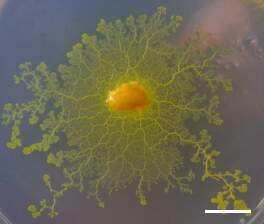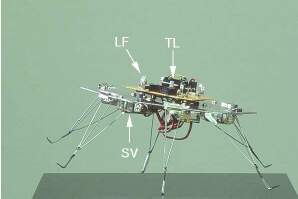Scientsists Let Slime Mold Control Robot Spider
NewScientist.com news service
Will Knight
A bright yellow slime mould that can grow to several metres in diameter has been put in charge of a scrabbling, six-legged robot.

The Physarum polycephalum slime, which naturally shies away from light, controls the robot's movement so that it too keeps out of light and seeks out dark places in which to hide itself.
Klaus-Peter Zauner at the University of Southampton, UK, who developed the slime-controlled bot with colleagues from Kobe University in south-central Japan, says the idea is to find simpler ways to control a robot’s behaviour.
Physarum polycephalum is a large single-celled organism that responds to food sources, such as bacteria and fungi, by moving towards and engulfing it. It also moves away from light and favours humid, moist places to inhabit.
Zauner's team decided to harness this simple control mechanism to direct a small six-legged (hexapod) walking bot.

They grew slime in a six-pointed star shape on top of a circuit and connected it remotely, via a computer, to the hexapod bot.
As the slime tried to get away from the light its movement was sensed by the circuit and used to control one of the robot's six legs. The robot then scrabbled away from bright lights as a mechanical embodiment of the mould.
Next, they will be using the slime mould to operate a hummer. Possibly they can use a weaponized slime mold vehicle to identify and eliminate enemies.
New Scientist Breaking News - Robot moved by a slime mould's fears
PDF paper reprint
Will Knight
A bright yellow slime mould that can grow to several metres in diameter has been put in charge of a scrabbling, six-legged robot.

The Physarum polycephalum slime, which naturally shies away from light, controls the robot's movement so that it too keeps out of light and seeks out dark places in which to hide itself.
Klaus-Peter Zauner at the University of Southampton, UK, who developed the slime-controlled bot with colleagues from Kobe University in south-central Japan, says the idea is to find simpler ways to control a robot’s behaviour.
Physarum polycephalum is a large single-celled organism that responds to food sources, such as bacteria and fungi, by moving towards and engulfing it. It also moves away from light and favours humid, moist places to inhabit.
Zauner's team decided to harness this simple control mechanism to direct a small six-legged (hexapod) walking bot.

They grew slime in a six-pointed star shape on top of a circuit and connected it remotely, via a computer, to the hexapod bot.
As the slime tried to get away from the light its movement was sensed by the circuit and used to control one of the robot's six legs. The robot then scrabbled away from bright lights as a mechanical embodiment of the mould.
Next, they will be using the slime mould to operate a hummer. Possibly they can use a weaponized slime mold vehicle to identify and eliminate enemies.
New Scientist Breaking News - Robot moved by a slime mould's fears
PDF paper reprint

1 Comments:
science is evil.
Post a Comment
Subscribe to Post Comments [Atom]
<< Home